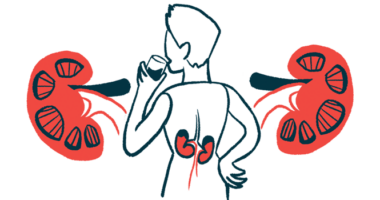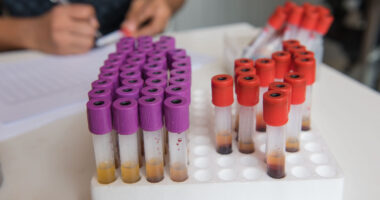Advanced screening may lead to early DMT start for ATTRv carriers
Biopsies, imaging may detect damage standard diagnostic tests do not: Study

Screening for toxic protein clumps using biopsies and advanced imaging techniques may help people carrying mutations that cause hereditary transthyretin amyloidosis (ATTRv) — a group of conditions that includes familial amyloid polyneuropathy (FAP) — to get an early start on disease-modifying treatment (DMT).
That’s according to a study in France that looked back at data from ATTRv carriers — those with a disease-causing mutation — who had normal results on standard nerve function tests.
These findings suggest that advanced screening methods can help identify patients with early signs of disease, even when these signs do not cause enough damage to be detected in certain diagnostic tests.
“Multimodal neurological and cardiac [heart] investigation of [ATTRv] carriers is crucial for the early detection of ATTRv amyloidosis and initiation of DMT,” the researchers wrote.
The study, “Detailed clinical, physiological and pathological phenotyping can impact access to disease-modifying treatments in ATTR carriers,” was published in the Journal of Neurology, Neurosurgery and Psychiatry.
Therapies most effective when started as early as possible
Hereditary transthyretin amyloidosis is a genetic disorder caused by mutations in the TTR gene that provides instructions for making the transthyretin protein. As a consequence of these mutations, transthyretin forms toxic clumps, called amyloid deposits, in the body’s tissues — causing damage that ultimately leads to disease symptoms.
FAP is a type of ATTRv that’s characterized by neurological symptoms due to buildup of toxic transthyretin aggregates mainly in the nerves outside the brain and spinal cord. But people with FAP also can have accumulating clumps in the heart, which can cause problems in its functioning.
When transthyretin clumps mainly accumulate in the heart, ATTRv is called hereditary transthyretin amyloid cardiomyopathy, or heart damage.
In recent years, several DMTs for FAP and other forms of ATTRv have become available. These therapies are most effective when started as early as possible in the course of the disease.
As such, there’s an increasing need to screen ATTRv carriers for early signs of disease so that treatment can be initiated as soon as these are detected. How best to do this type of screening remains controversial, however.
To know more, a team of scientists in France retrospectively reviewed data for 130 ATTRv carriers who were followed at a single center in the country. The patients had a mean age of 43.6, and 41% were men.
All had normal results on nerve conduction studies, called NCS, which are standard diagnostic tests that measure how fast nerves send signals and can help to detect nerve damage.
The carriers underwent a battery of clinical and laboratory tests that included, for the first time, both skin biopsies — to detect toxic transthyretin clumps in nerves — and an imaging technique called technetium-99m hydroxydiphosphonate bone scintigraphy, which can detect signs of amyloid deposits in the heart.
“We think that both punch skin biopsy and … scintigraphy should be performed in the initial evaluation, to maximize the chances of detecting amyloid deposition,” the scientists wrote.
Advanced screening techniques find amyloid deposits in over 15% of carriers
The results showed that 22 carriers (16.9%) tested positive for amyloid deposits on one or both of these tests.
Closer evaluation of clinical data indicated that nine of these individuals — 6.9% of all carriers — were already displaying overt disease symptoms. Specifically, five showed nerve damage and four heart damage.
All but two were started on DMT after this first evaluation. The two exceptions had very mild symptoms that were not getting worse during follow-up.
The other 13 amyloid-positive carriers — 10% of all carriers — were classified as having asymptomatic ATTRv because they did not have any obvious symptoms. But many of these patients showed some signs of nerve damage.
Most of them were started on treatment either after the first evaluation or after symptom onset during follow-up.
According to the researchers, these findings highlight that signs of disease may be identified even in carriers who have normal NCS results.
“If our cohort [patient group] is representative of the natural course of the disease in TTR gene mutation carriers, then clinical symptoms and abnormal NCS results should be considered the tip of the iceberg, with early [nerve damage] and progressive amyloid infiltration into target organs corresponding to the much larger, submerged part,” the team wrote.
Among the remaining 108 carriers who weren’t positive for amyloid deposits, 105 — 80.8% of all carriers — had isolated nerve and/or heart abnormalities of unknown significance. The most common were signs of damage to small nerves in the skin that are involved in sensation
“Only three carriers had no neurological or cardiac abnormality (2.3%),” the researchers wrote.
If our cohort [patient group] is representative of the natural course of the disease in TTR gene mutation carriers, then clinical symptoms and abnormal NCS results should be considered the tip of the iceberg, with early [nerve damage] and progressive amyloid infiltration into target organs corresponding to the much larger, submerged part.
These data suggest that nerve damage in ATTRv “probably becomes detectable before amyloid deposition,” the scientists wrote, adding that future research is needed to fully understand the clinical significance of these early signs of nerve damage.
Given this study’s retrospective and single-center nature, additional work is needed to verify these results, the team noted. Still, they emphasized that the data support the use of advanced screening tests for amyloid deposits to help facilitate early treatment in ATTRv carriers.
“Multimodal investigations of ATTRv carriers with normal NCS findings should include skin punch biopsy and [bone] scintigraphy for the detection of amyloid deposits, to make it possible to classify carriers into one of four categories: overt amyloidosis, asymptomatic amyloidosis, asymptomatic denervation and disease-free,” the researchers wrote.
“Early DMT can then be initiated immediately or during follow-up in the first two categories,” they concluded.








